#Native american style vests
Text
I made a little clothing guide for some Dragon Age regions
Some may not be exactly the same as the references that appear in the game or in the concepts, but I wanted to give a little of my vision to the guide.
Ferelden
Ferelden is close to the Frostback Mountains and Orlais and as Leliana and Zevran once said, Ferelden is cold, so I thought it would be a cool idea to put on thick clothes with a lot of fur so the Fereldans can protect themselves from the cold.
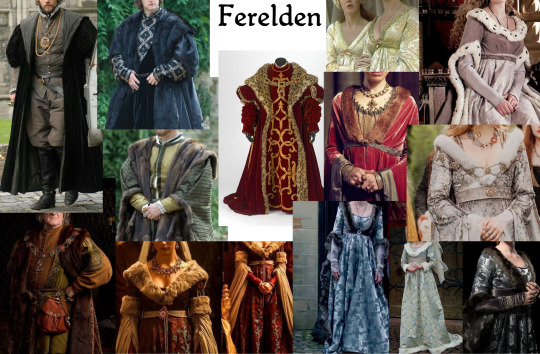
Tevinter
Dragon Age 4 is approaching and it's already evident that we're going to be in the Tevinter Imperium, so I discovered that a lot of Tevinter clothing was inspired by clothing from the Byzantine Empire
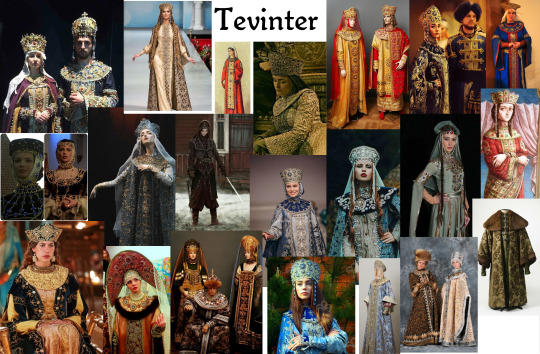
Orlais
We've already seen in the game and in the concept art that Orlais is all about being flamboyant and flashy and what's more flamboyant and flashy than mid-1500s fashion?
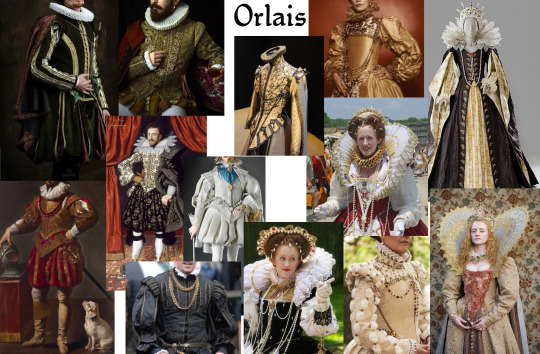
Antiva
Home to the two loves of my life, Zevran and Josephine, Antiva fashion is something I really love… The puffy arms, the breast-enhancing corsets, the leather vests, idk, I just like Antiva
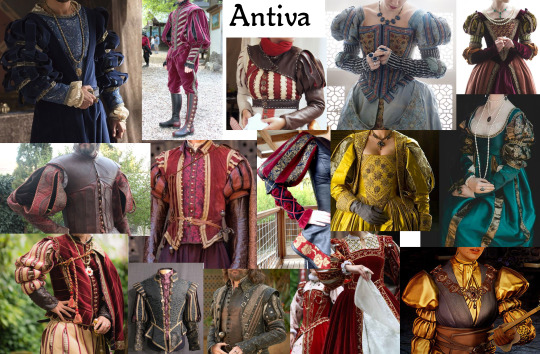
Nevarra
I don't exactly have much to say about nevarra, but I did some research and found some concepts that I thought were interesting, I also saw in some places that said that the kingdom was inspired by the traditional culture of Spain
So I'll leave two references here
One for the traditional clothes and one for what I imagine might look like Nevarra dress


Frostback Basin
In Inquisition we can see that the clothes they wear are quite furry and well protected from the cold, so I think it would be a good idea to inspire some of their clothing in Inuit clothing
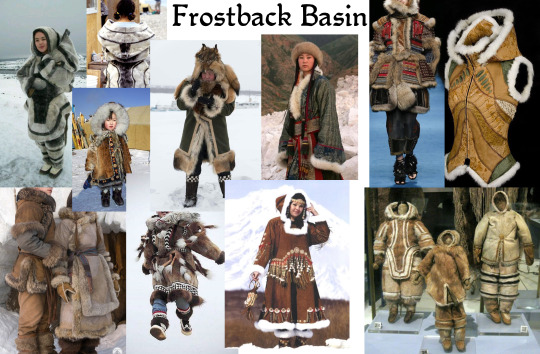
The Dalish (1/2/3/4/5)
Well, for the Dalish I had MANY ideas, among them think about adding traditional clothes from some tribes, native Brazilian/American, African, Hawaiian, Inca, Aztec and Mayan
Remembering that I made a great mix of traditional clothes from several tribes and not just one, and that I also have 0 intention of disrespecting any of them, if I have put something wrong or disrespectful you can be free to alert me
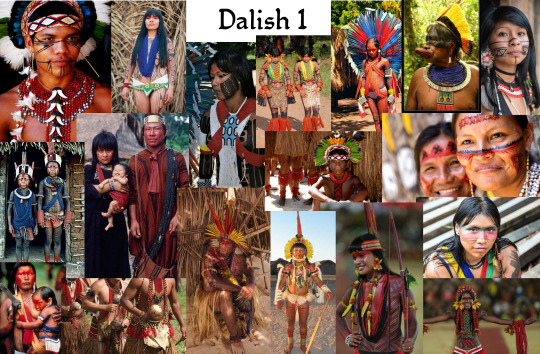


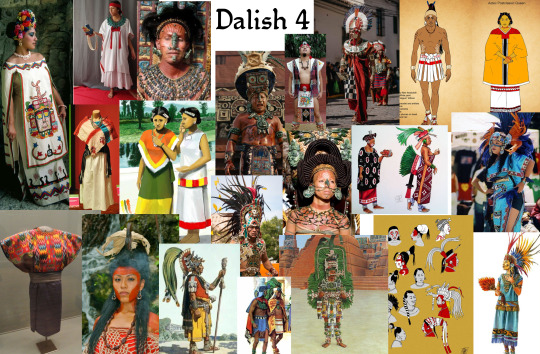
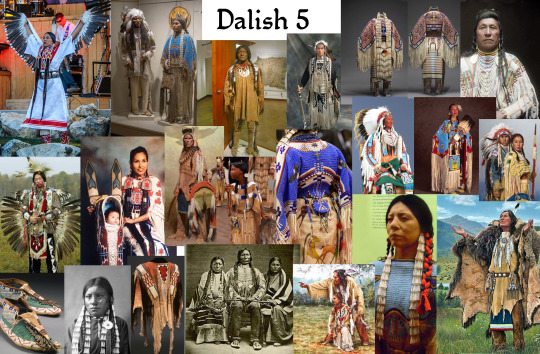
Orzammar
I knew little about Turkey, but when I went to research I ended up enchanted with some of the traditional clothes when I went to research about it and I thought that this style would go well with Orzammar
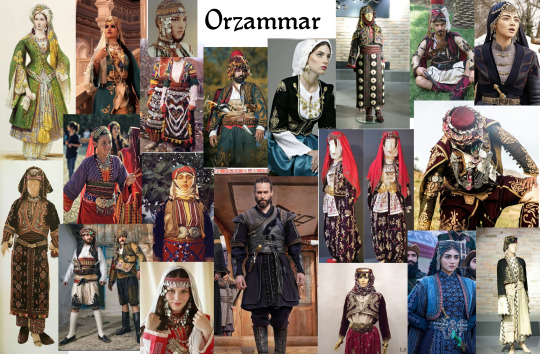
Par Vollen
For Par Vollen, I had a bit of trouble finding it, but I think clothing a little bit closer to the ancient Egyptian style would be something interesting. The light fabrics, the golden jewels adorning the body, idk, I like that idea

Rivain
I was doing some research again and found that part of Rivain's look was inspired by traditional clothing from Islamic Spain and Southeast Asia , so I looked around a bit for something to put here and add one more kingdom to the list
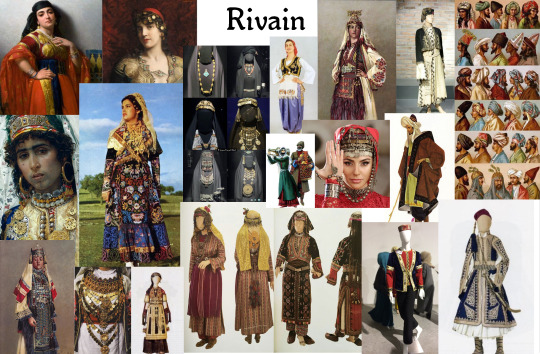
I hope you people enjoyed! Soon I will add more realms as soon as I finish my research
#dragon age fan art#dragon age 2#dragon age origins#dragon age#dragon age awakening#dragon age inquisition#tevinter#orlais#ferelden#frostback basin#antiva#nevarra#Rivain
4K notes
·
View notes
Note
Hi! You don't have to answer this if you don't want to, that's totally fine! But you talking about Orville Peck's appropriation of indigenous culture with his fashion choices made me realize that I had never considered that there might be some aspects of "cowboy clothes" that white ppl shouldn't wear and that was super wrong of me. Again, you totally don't have to answer this, but I was just wondering what ways a white person could wear "cowboy clothes" in a manner that wasn't disrespectful? Or perhaps, should we not wear them at all? I can't afford T yet, but when I can finally get it I was planning on getting a cowboy outfit to embrace my trans mascness, but if that would be wrong of me I can scrap that plan no problem!
Ehhh again this is actually SUPER HARD to answer because almost everything about cowboy fashion & the cowboy "aesthetics" are lifted directly from Native American fashion and culture, either because a lot of cowboys back in the day were Native American themselves (including Afro-Natives & Indigenous Mexican vaqueros) or they were White & just kinda. stole the look from the Native cowboys due to a number of factors.
If you google "cowboy jewelry" the first thing that comes up is silverwork & belts & turquoise jewelry, which is taken from Navajo metalwork. Fringed leather clothing? Again, many Native tribes did that (& in some tribes the fringes could mean something, its not just for looks), most popularily with vests, jackets, and pants. A lot if the leather jackets were a result of Native women just sewing their clothes the same but in a European styled cut. Compare this "cowboy" look below to a Lakota war shirt: both have hair embellishments dangling from the arms.


Studded belts? Inspired by Cheyenne mirror belts, which often also have metal studs in them & you'll still see Native pow wow dancers have this in their regalia. Floral vests? A lot of the inspiration comes from Plains floral beadwork. Geometric patterns and blankets? Came from Southwest or Mexican Native American blankets & designs, ask any Navajo weaver & they'll tell you the same. Feathers in cowboy hats? Who else is famous for wearing feathers on their heads--? Native Americans. The look is still popular with older Native men.
Hell, if you visit this site that sells Western/cowboy fashion, you'll see a SHITTON of appropriation going on, taking Native imagery & designs, including one taken from Native American ledger art, all on White models.

The appropriation of Native culture and fashion in the cowboy/western sphere is ongoing, and the influence that Native fashion & culture has in Western/cowboy fashion as it is is absolutely MASSIVE. I once said in another post that the cowboy/western aesthetic essentially belongs to Native Americans, Latines (especially Mexicans), and Black people. And the history of White cowboys has been one largely of colonialism, racism, and displacement of Indigenous peoples, and the masculinity associated with White cowboys especially is also steeped into racism & American patriotism (think John Wayne. There's a reason he's an American icon who played cowboys & killing Indians in films.). I think the only thing that isn't influenced from either appropriation or colonization is like, jeans. Even the style of cowboy boots themselves and potentially chaps were influenced from vaqueros.
So if you're White I'm not sure that'd exactly be a good route to take because trying to seperate Indigenous elements from this fashion/look (nevermind the problematic history of White cowboys) is almost impossible. Obviously I can't force you to do anything, but honestly if I were you, I'd try a different direction, because otherwise I think you'll find trying to do this will be very hard.
174 notes
·
View notes
Text

disabled people are beautiful!!!
(image description below the cut--it wouldn't fit in alt text!!)
a drawing of 15 disabled people on a yellow background with a light pink floral pattern. from left to right:
1. a fat white person whose left (their left) arm ends before the elbow. their right arm is on their hip, & they are smiling. they have short red hair, a yellow dress with white flowers, white hoop earrings, and black heels. they also have moles and are blushing.
2. a chubby middle eastern woman wearing a light pink embroidered abaya kaftan style robe and a slightly darker pink hijab. the robe's embroidery is delicate mauve vines around the sleeves, and two matching vines down the front. the woman has a german shepherd service dog with her. the. dog is sitting to the viewers right and has its tongue out, and is wearing a service dog vest. the woman is holding the leash to the dog in her right hand, and has her left hand on her hip. she is wearing pink slippers with a mauve gem on the top.
3. a black, bald, thin, nonbinary person with several facial piercings and earrings standing with their left arm lower than the right, slightly tilted backwards, arms hanging by their sides. they are wearing pink sandals, knee braces, a compression glove and elbow brace on their left arm, & have on blue shorts and a bright pink crop top that says 'FUCK ABLEISTS' (peep that underboob 👀 [side eye emoji]).
4. a chubby south asian woman with white hair and a green striped cane wearing a pale green button up shirt with shoulder pads, dark green corduroy pants, and brown loafers. her posture is tilted a bit from scoliosis.
5. a thin east asian man with a facial deformity that affects his nose and makes his left eye lower than the right. he has wavy pink har that is long on top and short on the sides. he is wearing a white cropped tank top with lace at the neck-line, and loose, flowy green pants. his shoes are white with pink detailing. he is turned so his body faces the viewer's right side, but is looking at the camera with his hands in his pockets.
6. a curvy latine autistic person holding a yellow AAC/speech tablet in front of their chest. they have very long light blue curly hair and freckles, and are smiling with their eyes closed. they are wearing dark blue headphones, a yellow short sleeve shirt, a dark blue romper with bows on the shoulders, and yellow sandals.
7. a curvy disabled bed-bound native american person lying in bed on their side facing the viewer and smiling. they have their left arm folded under their head, & their right arm laying next to heir face. the bed is dark brown with blue and white patterned sheets and a fuzzy purple blanket draped over the person and a corner is touching the ground. the person has tan skin and shaved brown hair.
8. a thin black woman with vitiligo, and wavy lime green hair with baby hairs, smiling in a wheelchair with lime green wheels. she is tilting the wheelchair back in a wheelie position. she is wearing a high-neck, sleeveless, black top with a boob window; light blue skinny jeans; tall, black lace-up boots; and dangly earrings.
9. an east asian man who has dwarfism. he is standing with his left hand on his hip, and his right hand up in a peace sign. he has square glasses and long, blonde, curly hair. he is wearing a black turtle neck, orange pants, and black booties.
10. a tall, curvy, white woman with forearm crutches. she is holding the crutch to her right normally, & is resting her left elbow and knee on the left crutch. her hair is shaved and brown on the right side of her head, and on the left side she has lair down to her chest colored in a rainbow pattern. she is wearing a dress that is pale pink with a pale yellow confetti pattern, pale yellow converse, and blue socks.
11. a drawing of a chubby, blind, south asian man. he has short, flowy, gray hair, black sunglasses, black stud earrings, a green sweater, a long black skirt, brown shoes, a gold key necklace, and a white cane. he has his right hand in front of him holding the cane, and his left hand by his side.
12. a fat black person sitting on the ground. their right elbow is resting on their right knee. their left leg is tucked in front of them on the ground, and their left hand is supporting them. they have short pink locs with the sides of their head shaved. they have a cleft lip scar and some moles on their face. they are wearing a black bra with a sheer long sleeve shirt over it, green shorts, and pink booties.
13. a drawing of a chubby latine man with an afro, mustache, and beard standing with his right arm behind his head. his left arm is holding up the end of a red dress with a deep v-neck to reveal his left leg is a prosthetic. he has chest, armpit, and leg hair, and is wearing gold jewelry and black flats.
14. a drawing of a disabled, curvy middle eastern woman with a feeding tube going from her nose to a bag on a pole. she is wearing a green shirt with a foliage pattern, tan shorts, and black combat boots with purple socks. her hair is also purple, and she has several earrings.
15. a drawing of a chubby native american man on a light blue background. he is using a blue rollator and waving. he is wearing a pink striped vest and vibrant green bell bottoms with pink flowers. his hair is long and blue, and he has three tattoo lines on his chin.
#rain creates#disability#disabled#cripple punk#limb loss#service dog#hypermobility#facial deformity#wheelchair#dwarfism#bed bound#me/cfs#feeding tube#blindness#rollators#crutches#scoliosis#prosthetics#autism#aac device
38 notes
·
View notes
Text

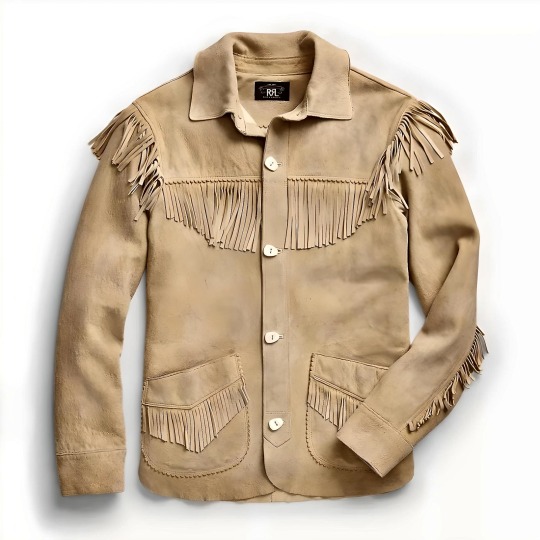

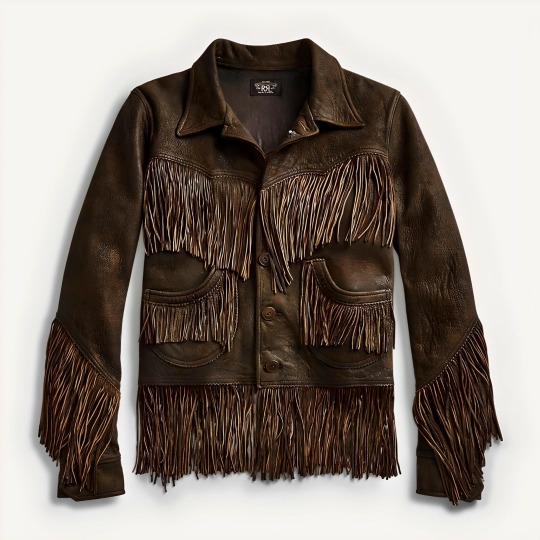

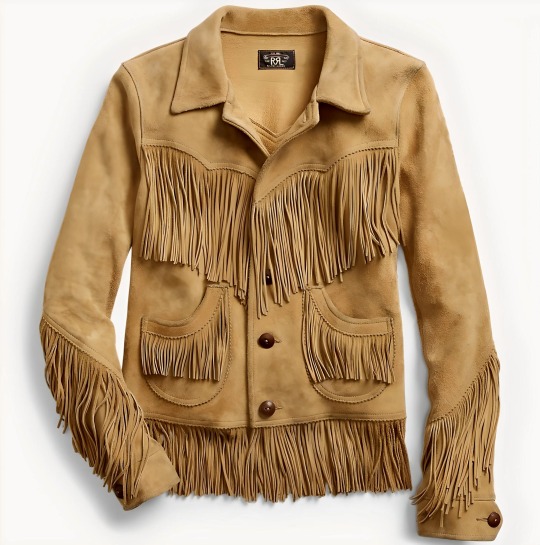
Legend has it that the origin of fringes on western wear can be traced back to Native American tribes who once roamed the vast plains of North America. Their garments, adorned with intricate strips of leather, acted as a natural barrier against the harsh wind, rain, and scorching sun. It also added a touch of flair and movement to their attire, symbolizing their connection to the untamed spirit of the land.
As settlers ventured West, they encountered Native American tribes and were captivated by their distinctive style - integrating some of these features into their own buckskin coats, vests, and chaps. Over time, fringe western clothing became intertwined with the mythology of the West. It became a staple in rodeos, saloons, and cattle drives - a testament to the bold and daring souls who once galloped those dusty trails.
#double rl#ralph lauren western#polo western#rrl western#doublerl#polo ralph lauren#rrl#ralph lauren#rrl exchange
25 notes
·
View notes
Text
VOY: Caretaker (Part 1)
Just like its predecessor, Deep Space Nine, Voyager opens with an expository text crawl explaining the current galactic situation. We learn about the Maquis – a plucky, non-Federation rebel group fighting the Cardassian occupation – then jump right into a heated space battle!

Fire! Raise shields! And somebody turn off that damned smoke machine!
As one would expect from a ragtag group of resourceful underdogs, the Maquis wear mismatched outfits made for trouble; we’re introduced to Chakotay and B’Elanna, both sporting rolled-up sleeves and tough leather vests.

Forearms mean business.
Tuvok is here too, although we don’t get a good look at his outfit from any of the angles in this scene. Chakotay makes up for it, however, by giving us a bit of a catwalk look at his duds: the patterned shirt is lovely, and probably meant to evoke his Native American heritage.
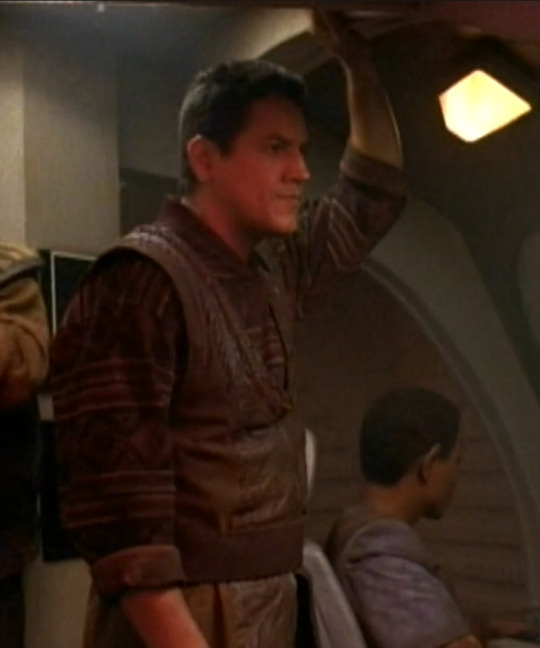
Actually, this may be the least problematic reference to his “heritage.”
Next, we’re taken to a sunny, verdant New Zealand penal colony, where Captain Janeway is busy picking out a boy toy. Unsurprisingly, we’re working with the same Starfleet uniforms currently in use on DS9, with a coloured section on the shoulders indicating department, and a grey turtleneck with rank pips underneath.

Get used to it – Voyager won’t be receiving wardrobe updates for about the next seven years.
Janeway finds the man she’s looking for – the boyishly handsome Nick Locarno Tom Paris – and hands him a “get out of jail free” card in the form of an invitation to join her crew. Tom considers her offer, weighing the excitement of adventure against having to give up his stylish prison coverall; the garment is concrete grey, with subtle shade differences across the chest and shoulders, not unlike a Starfleet uniform. I appreciate the asymmetry of the dark grey extending down the left sleeve, but not the right. The flap closure at the front is a little bit sexy, too, and along with the rolled-up sleeves, gives a “greasemonkey” vibe we’ll come to see a lot of from Tom.

The ankle monitor makes a nice accessory, too.
Meanwhile, Voyager is docked at Deep Space Nine, and we cut to a character we all know and love: Quark! …In the process of ripping off young Harry Kim. Although Quark’s ensemble technically belongs to another show, I still have to award it “best outfit” for the episode. The matching teal hues in the pants, shirt, and jacket is a beautiful bit of coordination, and it’s obvious the costume department has had a few seasons to perfect the character design. It’s not unusual for a Ferengi to dress so lavishly, but Harry should probably take it as a warning sign that he’s about to be ripped off.
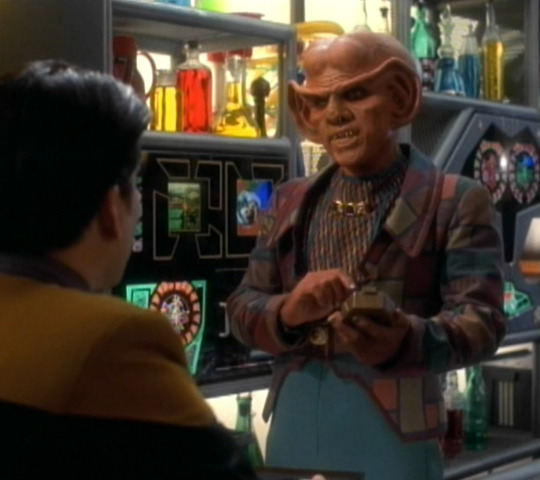
I’m sure he’ll be fine.
Up on the ship, Janeway has a chat with her fiancé Mark, who’s sporting a handsome wool-looking jacket in a dark mustard colour. Mark only gets about six lines and thirty seconds of screen time, so his outfit has to really pull its weight here building a character: handsome but approachable, smart but unpretentious, still shops at GAP in his 50s.

Sensible. I meant sensible.
There are no new costumes for a while as we meet the ship and crew, but we do get a few nice close-ups of Janeway’s lovely, elaborate updo – a more complicated style than the “bun of steel” she’ll wear in coming episodes.

Ignore the wig glue. It’s just… space sweat.
I suspect the stylist wanted all those extra swirlies in there because, once the action begins and our crew gets roughed up a bit, Action-Tousled Janeway looks amazing.
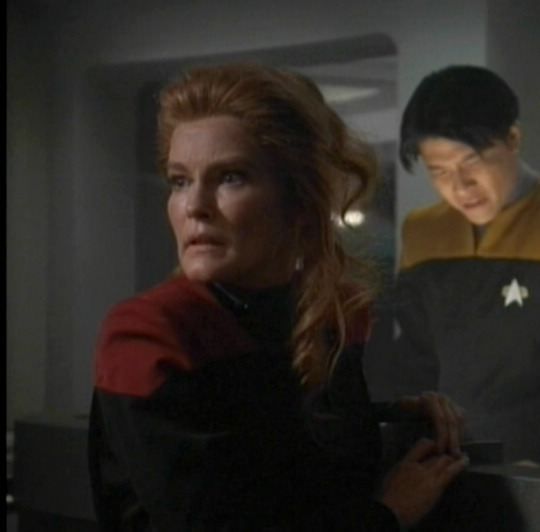
Slay, girl.
Harry and Tom go to sickbay, which is going to be full of patients very soon, and is also on fire. It’s hard to get a good look, but Harry puts on a cool Starfleet-issue oven mitt with metallic fabric to extinguish the fire.

Was that hole always there?
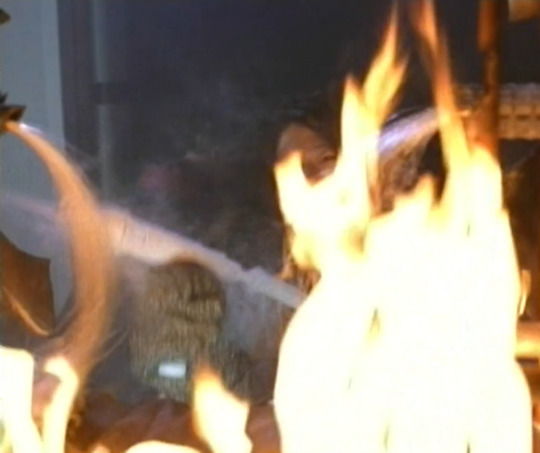
The least visible costume prop of all time.
In all the commotion, the crew realizes they’ve been zooped across the galaxy – 75,000 lightyears from home. But just when you thought we’d be stuck on a spaceship with one set of clothes for the next seventy years, we’re zooped again… to a southern country farm?! It looks exactly like Earth, and what looks like a perfectly human grandma comes out with cookies and lemonade to greet Janeway and co.
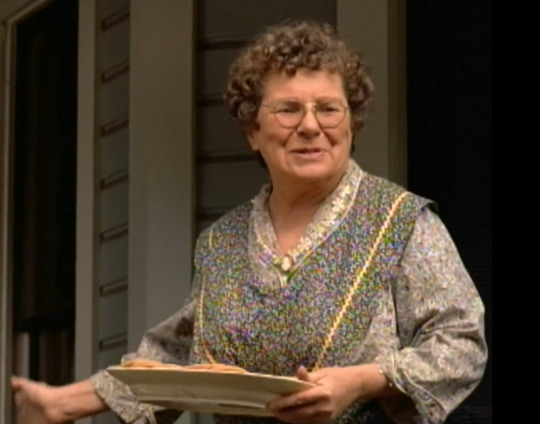
Floral fabric, ivory cameo, plate of cookies… yep, that’s a grandma.
She’s not alone, and soon the farm is full of completely “normal” “humans” having a good time, dancing and playing music. It’s literally the friendliest alien welcome party in history, but the Voyager crew are spooked. Moreover, they seem confused by the folksy straw hats and denim overalls.

Highly suspicious flannel.
With one exception: Tom Paris has quickly made friends with one of the illusory farm girls, a young woman in a cute printed dress with a belt, mary janes, and bright white ankle socks.
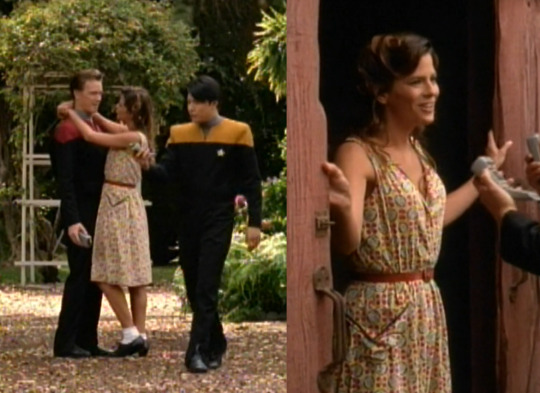
First contact: cottagecore edition.
However, Paris’ new friend gets a bit upset when they turn down her extremely tempting offers of a “real private” root cellar, a duck pond, and deviled eggs, and suddenly the farm folk aren’t so welcoming. The crew is zooped back to the ship – mostly. Harry Kim is missing.
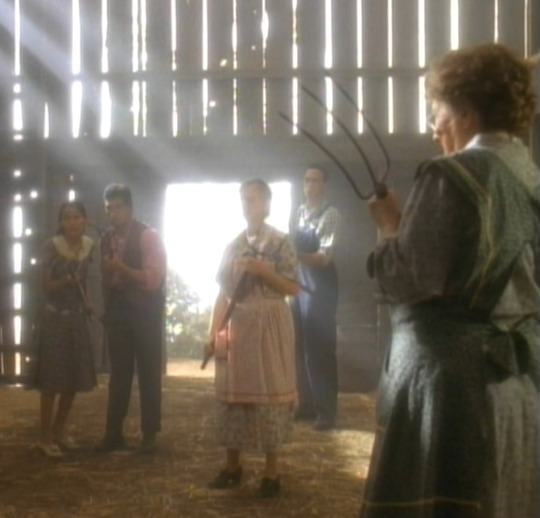
Get outta here! And take your synthetic fabrics with you!
Discovering a similar absence on the Maquis ship – B’Elanna is also missing – the two crews decide to work together to track down their people.
As they discuss plans, we finally get a good look at Tuvok’s Maquis disguise: he wears a cropped, open jacket made from a textured brown-green fabric, with sleeves in a lovely deep blue. The trim between the different fabrics is subtly shiny, giving the impression of leather straps. More importantly though, he wears an orange shirt underneath that appears to be stained at the collar – is that greenish hue Vulcan blood??
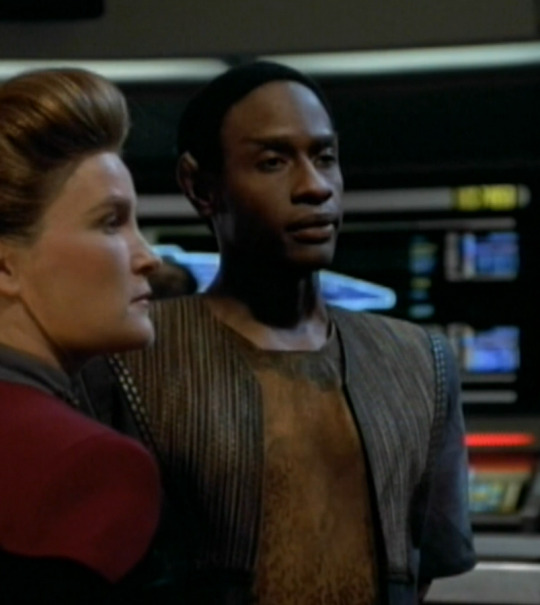
What happened to you in the Maquis, Tuvok?!
The episode isn’t out of costumes for us yet, though, and it’s a hard pivot from the dirty, worn-in clothes of the Maquis – as the viewpoint switches to that of our missing crewmembers, we find them in white clothing that resembles hospital gowns, albeit with an awkward strap closure that goes all the way around the back.
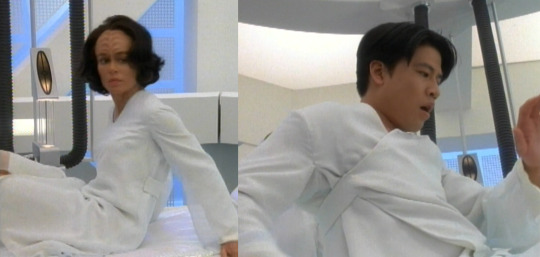
You know that strap has come undone and dipped in the toilet at LEAST once.
We also get our first look at the Ocampa, who at the moment are also clad in white, gauzy outfits. Unlike the “patients,” they wear strange fruit-netting-ish infinity scarves around their neck and head.

Keeps their melon safe.
The mesh fabric looks like it might be some kind of protective gear, but no, as we explore more of the compound, we see the truth: Ocampans just don’t know how to wear a scarf.

So close…
8 notes
·
View notes
Text
Embracing Freedom and Expression: The Timeless Allure of Hippie Clothing
Introduction: Hippie clothing, synonymous with the free-spirited counterculture of the 1960s and 1970s, continues to captivate hearts and wardrobes today. Rooted in a desire for peace, love, and self-expression, the hippie movement transformed not only societal norms but also fashion. The evolution of hippie clothing mirrors a rebellion against the constraints of mainstream fashion, embracing vibrant colors, flowing fabrics, and eclectic patterns that celebrate individuality.
The Bohemian Spirit
At the core of hippy clothing lies the Bohemian spirit — a rejection of conventionality in favor of free-thinking creativity. Flowing tie-dye shirts, bell-bottom pants, and fringed vests became iconic symbols of this movement, embodying a laid-back, carefree attitude. The fusion of cultures and global influences gave rise to a diverse range of styles, from Indian-inspired tunics to Native American prints, creating a rich tapestry of self-expression.
Natural Fabrics and Comfort
Hippie clothes embraced comfort and a connection to nature. Fabrics like cotton, linen, and hemp became staples, reflecting a desire for sustainable and breathable materials. Loose-fitting garments allowed for freedom of movement, reflecting the movement's rejection of restrictive societal norms. Tie-dye, a popular technique, not only added a burst of color but also symbolized the movement's psychedelic and experimental ethos.
DIY Culture: Central to the hippie fashion ethos was the do-it-yourself (DIY) mentality. Individuals adorned their clothing with handmade patches, embroidery, and unique accessories. This personal touch not only reflected the rejection of mass-produced consumerism but also celebrated the uniqueness of each individual. Vintage and second-hand clothing stores became treasure troves for those seeking one-of-a-kind pieces that resonated with their values.
Symbols of Peace and Love
Hippie clothing often featured symbols of peace, love, and spirituality. The peace sign, tie-dye patterns, and flower motifs were common elements, echoing the movement's anti-war sentiments and emphasis on harmony. Accessories such as beaded jewelry, headbands, and sandals adorned with peace symbols became iconic elements of the hippie wardrobe.
Modern Resurgence
While the original hippie movement may have peaked in the '60s and '70s, the spirit of free expression and individuality embedded in hippie fashion continues to influence contemporary style. Elements such as tie-dye, wide-brimmed hats, and fringe details regularly resurface on fashion runways and in mainstream retail, reflecting an enduring fascination with the carefree and rebellious spirit of hippie culture.
Hippie clothing is more than a fashion statement; it represents a cultural revolution that embraced individuality, peace, and love. The timeless allure of hippie fashion lies in its ability to transcend eras, inspiring new generations to embrace the Bohemian spirit and celebrate the beauty of self-expression. In a world that often craves conformity, the enduring legacy of hippie clothing serves as a colorful reminder of the power of freedom, creativity, and the pursuit of a harmonious existence.
0 notes
Text

Name: Ezra Cagney
Age: eternally 22 (actually from some sort of age of arcane prevalence, so who knows what his age is!)
Gender: Cis Male
Sexuality: Gay
Race: Tiefling (formerly human)
Appearance: fluffy red/ginger hair, hazel/yellow eyes, freckles, pretty face, slim build, dark red horns and tail hidden by a glamour.
Voice: light low tenor, has gotten good at mimicking a Texan accent; he could be mistaken for a native if not for the slight Irish lilt that comes out every so often. Most people just assume that the Texan accent is his natural one, and that the Irish one is just the nervous tick of a theater kid. He has a fair singing voice, though he usually only shows it off after a few drinks at karaoke night. His go-to songs are usually either punk rock or southern rock, occasionally classic rock, folk, or country.
FC: Trevor Stines
Personality: Charming, sweet, lonely, helpful, peacekeeper, honestly trying his best, seems shady at first but he’s really not, anxious and hiding it, seems confident but is actually awkward as all heaven and hell, loves a good stupid/ironic joke, dramatic as fuck, just charismatic enough to out-talk a devil without totally losing his shit, highly intelligent and nerdy, very intuitive, a bit of a show-off.
Powers/Abilities: functional immortality, fire magic, fire resistance, glamour, expert mixologist, alchemist, potion brewer.
Flaws/Weaknesses: hubris, holy water, extreme cold, binding contracts, lavender (he’s allergic, breaks out in hives), nearsighted
Nationality: ….American (for now), Irish (originally)
Languages: Too many to count
Education: An insanely long lifetime of various studies.
Style: dapper yet casual. Usually wears a black button down shirt, red vest, and black slacks. Red tie or jeweled bolo if he’s going to a meeting or event of any kind. He often dresses up for theme nights at the tavern, though he always manages to look as classy as possible. Wears black rectangular glasses, and a silver ring in each ear.
Profession: bartender (current), alchemist (former, recently started again), wizard (former, still dabbles), co-owner of the Heavenly Fire Tavern & Grill.
Family: long gone, unless found family counts
Backstory: Ezra has been in Morningstar for at least a couple of decades, probably closer to three. It’s both a haven and a prison for him, though far more so the former. He’d spent centuries on the run, doing whatever good deeds he could along the way, but when he finally found a small town that seemed to be just as weird as he was, he jumped at the chance to settle down for a while. It wasn’t easy. Between the prickly locals and the deal that he’d made for immortality, which he was nearly in breach of, Ezra quickly became overwhelmed. He bounced back, though, opening a tavern with the help of a friendly local mechanic through which he could continue his eternity of servitude in peace. Until, of course, he figured out that he could no longer leave Morningstar. The contract between him and the mechanic had accidentally bound him to remain in town for as long as it remained in effect, and while that did have its drawbacks, he honestly didn’t mind. The devil he’d (mostly) outsmarted so long ago could hardly reach him, and he had a safe place to call home where no one minded the fact that he never aged. Things were great! Aside from the local Chamber of Commerce being mostly full of catty and conniving assholes, Ezra could finally take it easy. Twenty years of peace. Twenty years of finally feeling like he could belong, of having a friend who felt more like a brother, and of prospering like he never had before.
When the old mechanic died, it shattered Ezra to his core. He didn’t open up the tavern for nearly a week, and only left his home to attend the funeral, where he met the mechanic’s grandson, Oleander, formally for the first time. He put on a brave face, much like the one the boy and his widowed grandmother wore, kept his introductions brief, and paid his respects. After the funeral, Ezra’s life became a little more bearable; he reopened the tavern and went about his days as he usually would, though he dreaded the next CoC meeting. It would be quite lonely and anxiety inducing to try and keep the peace on his own. When it finally rolled around Ez was a nervous wreck, but he was pleasantly shocked to see that Ollie had showed up in his grandfather’s stead.
Good.
They needed to talk if Oleander had truly inherited both family businesses, and the meeting would be a good icebreaker. He hoped. Ezra was quick to lay on the charm, introducing Ollie to the other members and trying his best to keep the wolves at bay. Despite his efforts, Ollie remained leery of him and the rest of the Chamber. It took longer than he’d hoped to earn just a little bit of the boy’s trust, even that was only gained because Ezra became a target for attempted murder and came to Ollie for help. He would never forget the look on the boy’s face upon seeing the fresh holy water burns, or the conversation they had as Grandma Rose patched him up.
Their friendship was soon forged in chaos and mutual aid, as they came together to root out and defeat the so-called monster hunters, and solidified when Ollie agreed to renew his grandfather’s contract for co-ownership of the tavern. It wasn’t long before the pair became well known for their arcane prowess. Townsfolk began coming to them for spells and potions, wards and talismans. It was practically something out of a fantasy novel, as if Ezra’s life hadn’t reflected one before.
#🔧 out of spells 🔧 ooc talk#🍷 alchemist and mixologist 🍷 about#🍷 if heaven and hell decide 🍷 aesthetic
1 note
·
View note
Link
Check out this listing I just added to my Poshmark closet: Vintage Colorful Embroidered Floral Vest Artisan Made in Guatemala Medium Unique.
0 notes
Text
Friday, December 30, 2022
In Much of the South, Subfreezing Weather Crippled Water Systems
(NYT) As soon as he saw that temperatures would nosedive to subfreezing lows over the Christmas weekend, Richard White had a strong hunch about the trouble it would spell for his community in Mississippi even after the ice had thawed: Frozen pipes would burst, and water in the system would stop flowing. Sure enough, that’s what happened. It was the same across much of the Southeast, where the bitter cold was long gone—the high in Byram skirted 70 degrees on Wednesday—but the fallout from the recent winter storm endured in the form of broken pipes, disrupted water systems and widespread aggravation. Byram, which relies on Jackson’s long-troubled municipal water system, has been under a boil-water advisory for several days, as are hundreds of thousands of people in Memphis after more than three dozen water main breaks there. In Charleston, S.C., officials warned that the storm thrust the water system alarmingly close to catastrophe. In Selma, Ala., a series of major leaks led the mayor to declare a state of emergency. Pipes also burst at the airports in Atlanta and Birmingham, Ala., inserting yet another bump into a holiday travel season transformed into an obstacle course of cancellations and delays.
Americans abroad
(Washington Post) We all know that America is a nation of immigrants (with the obvious exception of its long-marginalized Native population). But every so often, it feels like it’s on the verge of becoming a nation of emigrants. According to recent Gallup polls, as many as 15 percent of Americans say they want to leave the country permanently, and even more say they would consider expatriating under the right circumstances. But only a small fraction of Americans have actually taken the plunge, data shows. While the United States is the top destination for immigrants worldwide, hosting about three times as many immigrants as runners-up Germany and Saudi Arabia, it’s a paltry 26th in terms of sending immigrants abroad. Our analysis of U.N. data finds that just one American emigrates for every six Indians or four Mexicans. The United Nations and World Bank estimate the population of American-born people abroad at around 2.8 million as of 2020.
Mexico draws more asylum-seekers despite grisly violence
(AP) Albert Rivera knows well how dangerous Mexico can be: He sometimes wears a bulletproof vest around the compound of bright yellow buildings that he built into one of the nation’s largest migrant shelters. His phone stores more evidence in the form of stomach-churning videos that gangs sent migrants to warn of consequences for disobeying demands. But across town from the Agape Mision Mundial shelter, many migrants are grateful for a chance to settle here. That’s where Mexico’s asylum office greets foreigners who consider the border city of Tijuana a relatively safe place to live with an abundance of jobs. The jarring contrast speaks to Mexico’s conflicted status. It is a country where violence and inequality chase many people to seek a better life in the United States. For others it offers a measure of peace and prosperity beyond what’s available in their homelands.
After presidency, unclear fate for Brazil’s brash Bolsonaro
(AP) Jair Bolsonaro told supporters that the future could only bring him three possibilities: arrest, death or a second term as Brazil’s president. one of those outcomes came to pass. And his Oct. 30 loss to Luiz Inácio Lula da Silva set off two months of relative silence for the self-styled standard-bearer of the Brazilian conservative movement. Bolsonaro’s oft-cited motto is “God, Family, Country,” and as president he handed more power to the armed forces and loosened gun restrictions. Many of Bolsonaro’s far-right supporters remain in his thrall and have camped outside military buildings, pleading futilely for army intervention that would keep the president in power. But Bolsonaro authorized his chief-of-staff to preside over the transition process, and moving trucks have started showing up at the presidential palace and residence.
Britain’s Soaring Energy Costs Strain Crisis Responders
(NYT) The day after an arctic blast of air hit Britain, plunging temperatures below freezing and blanketing the country in frost, a 72-year-old man finally got through to the advice phone line of Warm and Well, a charitable service in Gloucestershire, in the west of England. The man, whose name was not disclosed, said he had been calling for days and leaving voice mail messages with the nonprofit, which provides advice and emergency funds for people struggling to pay their energy bills. Teresa Hewitt, the energy adviser who answered his call, could only commiserate. “We are absolutely overwhelmed at the moment,” she told him. She was one of seven staff members answering the phones that day in early December who were attempting to field 71 calls. Across Britain this winter, more people are falling into debt and sitting in cold or damp homes as a result of rising energy bills, which have helped push the country’s inflation rate above 10 percent. This sharp increase in what is called “fuel poverty,” when 10 percent of household income is spent on energy bills, is stretching the resources of charities that provide free advice, emergency funds or resources to get access to heat.
Sarajevo’s agony echoes as Ukraine braces for a dark winter
SARAJEVO, Bosnia-Herzegovina (AP)—Vildana Mutevelić huddled in her apartment with her two young children and elderly cousins. They had no heat, electricity or running water as artillery shells tore the roof off their building and almost took their lives. To survive, she improvised. Mutevelić made a lamp out of used engine oil, water and a shoelace for a wick. She cooked on a fire fueled by books, furniture, shoes or clothes. A plastic spoon, she discovered, when lit, worked well as a temporary flashlight if she ventured outside. Plastic sheets covered the blown-out windows, a flimsy buffer against the bitter cold. Her news of the world came from a neighbor who powered a radio with a car battery. “The electricity failed right away,” Mutevelić, 70, said through a translator. “And everything we had in our freezers, it melted. Those were our stocks, basically. That’s all.” For Mutevelić, these are memories from three decades ago, when Bosnian Serbs besieged Sarajevo, causing thousands of civilian casualties. But it’s all happening again in Ukraine. Russia’s armed forces have aimed their firepower at Ukraine’s energy infrastructure as winter weather sets in.
Hard-Line Positions by Russia and Ukraine Dim Hope for Peace Talks
(NYT) As the battle for Ukraine turns into a bloody, mile-by-mile fight in numbing cold, Ukrainian and Russian officials have insisted that they are willing to discuss making peace. But with a drumbeat of statements in recent days making clear that each side’s demands are flatly unacceptable to the other, there appears to be little hope for serious negotiations in the near future. Ukraine this week proposed a “peace” summit by the end of February, but said Russia could participate only if it first faces a war-crimes tribunal. That drew a frosty response from the Kremlin, with Foreign Minister Sergey V. Lavrov saying that Kyiv must accept all of Russia’s demands, including that it give up four Ukrainian regions that Moscow claims to have annexed. “Otherwise,” he said, “the Russian Army will deal with this issue.” The hard-line positions suggest that both sides believe they have more to gain on the battlefield, analysts say.
Lack of info on China’s COVID-19 surge stirs global concerns
(AP) Moves by the U.S., Japan and others to mandate COVID-19 tests for passengers arriving from China reflect global concern that new variants could emerge in its ongoing explosive outbreak—and the government may not inform the rest of the world quickly enough. There have been no reports of new variants to date. But given the country’s track record, the worry is that China may not be sharing data on any signs of evolving strains that could spark fresh outbreaks elsewhere. The U.S., in announcing a negative test requirement Wednesday for passengers from China, cited both the surge in infections and what it said was a lack of information, including the genomic sequencing of the virus strains in the country.
U.S. Scrambles to Stop Iran From Providing Drones for Russia
(NYT) The Biden administration has embarked on a broad effort to halt Iran’s ability to produce and deliver drones to Russia for use in the war in Ukraine, an endeavor that has echoes of its yearslong program to cut off Tehran’s access to nuclear technology. In interviews in the United States, Europe and the Middle East, a range of intelligence, military and national security officials have described an expanding U.S. program that aims to choke off Iran’s ability to manufacture the drones, make it harder for the Russians to launch the unmanned “kamikaze” aircraft and—if all else fails—to provide the Ukrainians with the defenses necessary to shoot them out of the sky. The breadth of the effort has become clearer in recent weeks. The administration has accelerated its moves to deprive Iran of the Western-made components needed to manufacture the drones being sold to Russia after it became apparent from examining the wreckage of intercepted drones that they are stuffed with made-in-America technology.
Netanyahu government: West Bank settlements top priority
(AP) Benjamin Netanyahu’s incoming hard-line Israeli government put West Bank settlement expansion at the top of its priority list on Wednesday, vowing to legalize dozens of illegally built outposts and annex the occupied territory as part of its coalition deal with ultranationalist allies. The coalition agreements, released a day before the government is to be sworn into office, also included contentious judicial reforms, as well as generous stipends for ultra-Orthodox men who prefer to study instead of work. The package laid the groundwork for what is expected to be a stormy beginning for the country’s most religious and right-wing government in history, potentially putting it at odds with large parts of the Israeli public, rankling Israel’s closest allies and escalating tensions with the Palestinians.
0 notes
Text
Western Leather Hand Bag - Your Ultimate Choice
When you think of going outside the house, some things needed to be with you and handbags are one of them. Handbags are one of the important items of your wardrobe even if you are at home i.e. you will feel incomplete without a bag filling all your needs.
There is no other accessory that offers more dollar values than a leather bag. Handbags are also considered a statement of modes needed by every woman. You have to find a perspective where you need it. Actually the need must be remembered before choosing a leather bag.

Leather is a material that is one of the best items and durable. It is hardened from everything and it is the right material used for handbags. Leather is largely dependent on the tanning process. These western leather hand bags are available in all kinds of texture and can be seen from boring to shiny. The leather is of course the most durable and beautiful thing that is used for this purpose that lasts for years.
Fashion is something that determines the way and someone's personality. You can identify individuals by visualizing the things they carry and if things go according to personality and appearance then that means you are the most noble and fashionable.
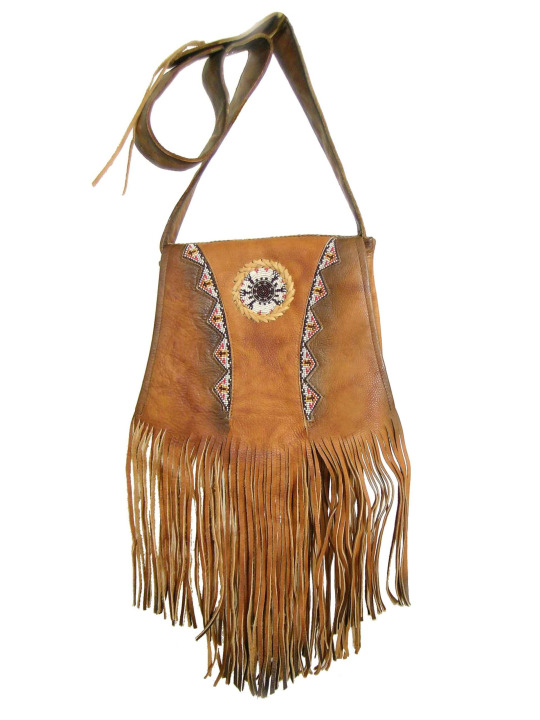
The concept behind having a leather handbag according to your numbers is that the bag should not look like something giant when you have a very fine appearance. A woman, who is tall and thin, needs a round bag or unstructured for a woman with a high height, the best choice will be a small rectangular bag.
#Cowboy jackets#Western wear trade shows#Western wear jackets#Western wear vests#Native american style vests#Native american style leather bags
1 note
·
View note
Text

i've been drawing disabled people for disability pride month, & i put all the ones i've done so far together!! :D
(the description wouldn't fit in the alt text, so it's below the cut)
a drawing of 15 disabled people on a yellow background with a light pink floral pattern. from left to right:
1. a fat white person whose left (their left) arm ends before the elbow. their right arm is on their hip, & they are smiling. they have short red hair, a yellow dress with white flowers, white hoop earrings, and black heels. they also have moles and are blushing.
2. a chubby middle eastern woman wearing a light pink embroidered abaya kaftan style robe and a slightly darker pink hijab. the robe's embroidery is delicate mauve vines around the sleeves, and two matching vines down the front. the woman has a german shepherd service dog with her. the. dog is sitting to the viewers right and has its tongue out, and is wearing a service dog vest. the woman is holding the leash to the dog in her right hand, and has her left hand on her hip. she is wearing pink slippers with a mauve gem on the top.
3. a black, bald, thin, nonbinary person with several facial piercings and earrings standing with their left arm lower than the right, slightly tilted backwards, arms hanging by their sides. they are wearing pink sandals, knee braces, a compression glove and elbow brace on their left arm, & have on blue shorts and a bright pink crop top that says 'FUCK ABLEISTS' (peep that underboob 👀 [side eye emoji]).
4. a chubby south asian woman with white hair and a green striped cane wearing a pale green button up shirt with shoulder pads, dark green corduroy pants, and brown loafers. her posture is tilted a bit from scoliosis.
5. a thin east asian man with a facial deformity that affects his nose and makes his left eye lower than the right. he has wavy pink har that is long on top and short on the sides. he is wearing a white cropped tank top with lace at the neck-line, and loose, flowy green pants. his shoes are white with pink detailing. he is turned so his body faces the viewer's right side, but is looking at the camera with his hands in his pockets.
6. a curvy latine autistic person holding a yellow AAC/speech tablet in front of their chest. they have very long light blue curly hair and freckles, and are smiling with their eyes closed. they are wearing dark blue headphones, a yellow short sleeve shirt, a dark blue romper with bows on the shoulders, and yellow sandals.
7. a curvy disabled bed-bound native american person lying in bed on their side facing the viewer and smiling. they have their left arm folded under their head, & their right arm laying next to heir face. the bed is dark brown with blue and white patterned sheets and a fuzzy purple blanket draped over the person and a corner is touching the ground. the person has tan skin and shaved brown hair.
8. a thin black woman with vitiligo, and wavy lime green hair with baby hairs, smiling in a wheelchair with lime green wheels. she is tilting the wheelchair back in a wheelie position. she is wearing a high-neck, sleeveless, black top with a boob window; light blue skinny jeans; tall, black lace-up boots; and dangly earrings.
9. an east asian man who has dwarfism. he is standing with his left hand on his hip, and his right hand up in a peace sign. he has square glasses and long, blonde, curly hair. he is wearing a black turtle neck, orange pants, and black booties.
10. a tall, curvy, white woman with forearm crutches. she is holding the crutch to her right normally, & is resting her left elbow and knee on the left crutch. her hair is shaved and brown on the right side of her head, and on the left side she has lair down to her chest colored in a rainbow pattern. she is wearing a dress that is pale pink with a pale yellow confetti pattern, pale yellow converse, and blue socks.
11. a drawing of a chubby, blind, south asian man. he has short, flowy, gray hair, black sunglasses, black stud earrings, a green sweater, a long black skirt, brown shoes, a gold key necklace, and a white cane. he has his right hand in front of him holding the cane, and his left hand by his side.
12. a fat black person sitting on the ground. their right elbow is resting on their right knee. their left leg is tucked in front of them on the ground, and their left hand is supporting them. they have short pink locs with the sides of their head shaved. they have a cleft lip scar and some moles on their face. they are wearing a black bra with a sheer long sleeve shirt over it, green shorts, and pink booties.
13. a drawing of a chubby latine man with an afro, mustache, and beard standing with his right arm behind his head. his left arm is holding up the end of a red dress with a deep v-neck to reveal his left leg is a prosthetic. he has chest, armpit, and leg hair, and is wearing gold jewelry and black flats.
14. a drawing of a disabled, curvy middle eastern woman with a feeding tube going from her nose to a bag on a pole. she is wearing a green shirt with a foliage pattern, tan shorts, and black combat boots with purple socks. her hair is also purple, and she has several earrings.
15. a drawing of a chubby native american man on a light blue background. he is using a blue rollator and waving. he is wearing a pink striped vest and vibrant green bell bottoms with pink flowers. his hair is long and blue, and he has three tattoo lines on his chin.
#disability pride month#disabled#disabled artist#chronic illness#limb difference#service dog#hypermobility#elhers danlos syndrome#pots syndrome#scoliosis#cane user#cripple punk#bed bound#bedridden#mecfs#cfs#chronic fatigue syndrome#facial deformity#actually autistic#speech tablet#wheelchair#dwarfism#forearm crutches#cleft lip#cleft palate#blindness#prosthetic#feeding tube#rollators#rain creates
5 notes
·
View notes
Text

It's my boy Eljonik!! He spends a few days all alone this way.
I didn't actually describe him as having designs placed on his wrists but I wanted to put more on him and his palms aren't showing >.> The designs take influence both from Polynesian tattoos and I lifted elements directly from PNW Native American art (idk if this art style is specific to my area or not, but I grew up with it).
[img id: a young dark-skinned man sits on a red cushioned bench in a corner with his head tilted away from the viewer as if resting against his shoulder or the wall, left leg (furthest from the view) pulled up while his right leg stretches out before himself. His hands are crossed over his right thigh, resting. A gentle light from above illuminates the scene.
He wears a sheer green vest trimmed in gold, and yellow-gold knee-length pants. His dark red hair is short in the back and longer in the front, as if cut while tied back. Dark brown temporary tattoos (Mehndi/Henna type) encircle his neck and wrists. His right calf is wrapped in bandages and he has a large bruise on his upper right arm. /end id]
38 notes
·
View notes
Photo

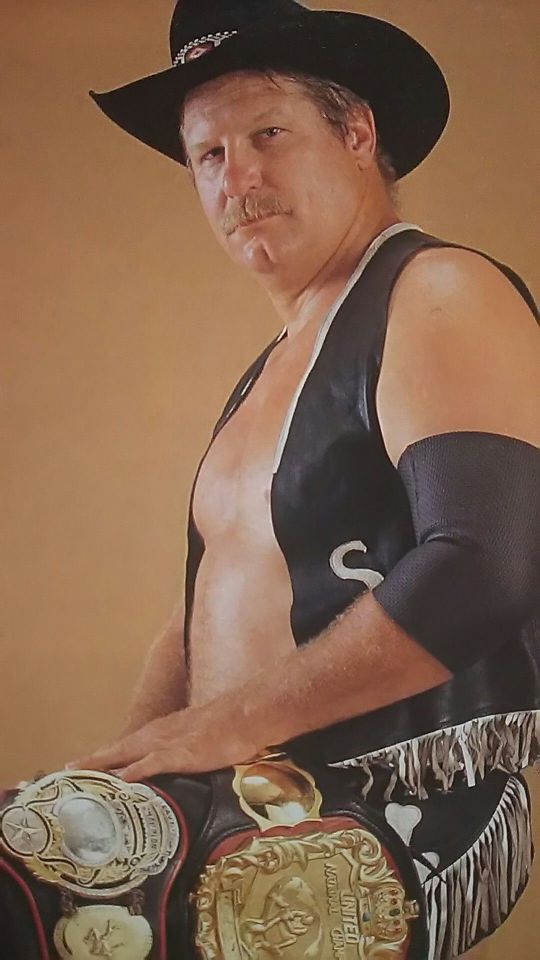


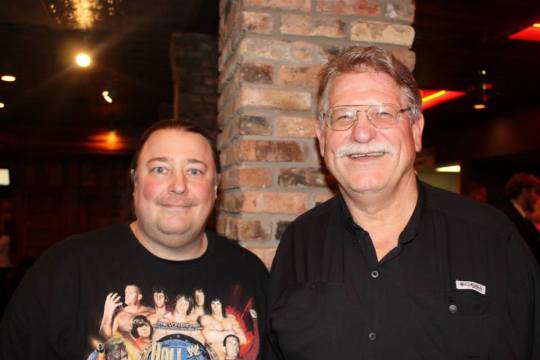
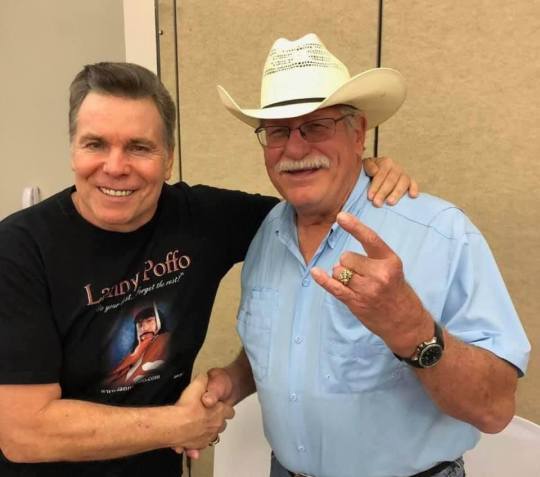

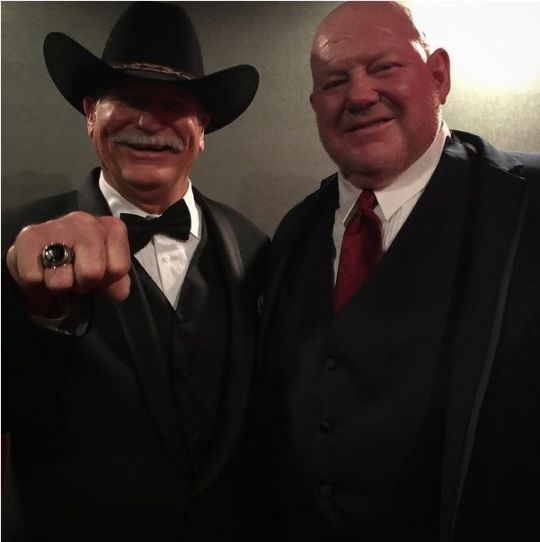


Stan Hansen
Born: August 29, 1949, United States
Physique: Average Build
Height: 6'4" (1.93 m)
John Stanley Hansen II is an American retired professional wrestler. Hansen is known for his stiff wrestling style, which he attributes to his poor eyesight. He is also known for his gimmick as a loud, violent cowboy who wanted to fight everybody, which he further emphasized by appearing in interviews with a cowboy hat, leather vest and bullrope while often chewing on tobacco. Considered the most successful and popular gaijin in Japanese professional wrestling history, he became more well-known and revered in Japan than in his native United States. In Japan's AJPW promotion, he held seven different championships. Overall he is a six-time world champion.
As a kid, I couldn't tell why the scowlly faced, bullrope carrying cowboy with tobacco dripping from his lip fascinated me so. Now I can. I wanted him to pin me down in the ring. Even now. Married with four children, two with his current wife. The WWE Hall of Famer now needs some stories or video to come out with him fucking something to round off his career. It feels incomplete without it. What?
43 notes
·
View notes
Text
Human!Turts musings:
Raphael - Native American/Asian.
More specifically, he is a Lenape / Japanese mix. Lenape was my tribe of choice as they inhabited Manhattan. He would probably look the least like Yoshi simply because of his size. He would retain his snaggletooth of course since its a signature feature of him. He would probably change the least in regards to his day to day, and would still rarely go out unless it was for patrol or accompanying his brothers. He doesn’t really care what he is, human or turtle, so he would be fine either way.
Donatello - Asian mix
Listen, I thought that spiny softshells were from Asia for the longest time so I always imagined Donnie as being completely Asian, so it’s almost impossible to imagine anything else for him. Like Leo, he looks so much like Yoshi that it is uncanny, though slightly less so than Leo. He makes an effort to look less like Yoshi, but it’s obvious. Even more upset that he and Leo are now basically proven twins since they’re practically identical. He becomes known forever as ‘Leonardo’s brother’ and nothing more. Poor boy. Gets accepted to college at Like 15 and graduates a year later just to spite Kendra as they’re in the same class. Definitely does drama and theatre on the weekend. Parties almost as much as Leo, but give this ambivert some space when he needs it!
Leonardo - Mexican/Asian
Giving the fact that Leonardo obviously enjoys Spanish in general, it just made sense to place his other half somewhere in Mexico! Of course, he still has Splinter genes since I imagine him almost as a carbon copy clone of Yoshi! He would emulate his father’s old style constantly and convince everyone he can that he is in fact lou jitsu’s son. He’d brag about it any time he can! Him going to lots of parties, even more than Mikey, and just enjoying life. His markings become like vitiligo markings!
Michelangelo - Black/Native American/Asian.
More specifically, he would be part African American, part Navajo, and part Japanese. Like with Donatello, the choice of making him a different race than where box turtles would usually be found is a creative choice. He also has part Navajo as I still wanted to incorporate The native homeland of box turtles somewhere in him. Perhaps he was owned by a little black boy before his mutation and that’s why he expresses traits of all three! Also, his spots expressing as freckles and beauty marks! Just imagine April helping him to manage his hair when splinter has no idea where to start since it’s such a different texture than his! Mikey complaining about his hair always being messy in the morning April gives him a durag as a gift. Mikey definitely collects them!
Michelangelo would be the most dysphoric about the change and very open about it. He might do things like taping his fingers together to ease the transition, or wearing vests. If it was a permanent change, then he’d spend the earlier years simply trying to retrain his body and get some sense of himself back. Raph couldn’t care either way What species he is, and would probably never change his habits or traits. Leonardo and Donatello would accept the change almost immediately and try to integrate into human society as soon as they can; Donnie might harbor some secret dysphoric tendencies, but not near as openly bad as Mikey. Leonardo would honestly thrive as a human— All of the brothers world after an adaptation period, though it would vary brother to brother. All of them struggle with the learning curve of how much hits to the chest and back hURT when there isn’t a giant lump of bone protecting you. Plus, they’re not as durable as they were as mutants, so injuries ahoy! Plus ‘what do you mean I can’t hold my breath for a few hours hOW CAN I TAKE MY WATER NAPS NOW?!’
@ilo-artistry @brightlotusmoon
15 notes
·
View notes
Text
“...First, let’s talk about materials. We can rule out a Steppe Nomad inspiration for any of this right off. The Eurasian Steppe is very large and covers a range of arid climates (that is to say, parts of it are colder, parts of it are warmer), but they all have spinning and weaving technology, by which the supple hairs of woolly animals, or plant fibers like linen, or cotton, or even natural protein fibers like silk can be fashioned into fabric which is more flexible, comfortable, breathable and temperature controlled than the raw leather we see in the show.
...there is a distinct lack here of lots of leather, except in the sort of things that lots of cultures use leather for (boots, fittings, saddles, bags, tents). Instead, clothing is mostly made out of nice, comfortable, breathable textiles, because of course it is. That is not to say, to be clear, that leather or hides or fur were never used – fur especially was used; merely that they were generally used to supplement clothing primarily made out of textile.
...Now Plains Native American clothing does make much greater use of animal skin as a clothing material, but there is an important distinction to be made here. The problem here is with the plasticity of the term ‘leather’ which can technically include a wide range of products, but in practice is understood to mean exactly what the Game of Thrones costume department and literally every piece of official artwork of the Dothraki understand it to mean, which is the product of tanning processes.
I am not an expert, but as far as I can tell, Native American clothing was not made in the same way; animal products were used in a process I have seen described as ‘brain tanning’ (rather than using chemical tannins) and the final product was then smoked. The result – which is often called ‘buckskin’ regardless of the animal source for the hide – is very different from the leather we see in the show.
This is, in terms of material, very clearly not what the ‘vests’ the Dothraki in the show are wearing. Buckskin would also be used to make trousers, as opposed to the “horsehair leggings” of Martin’s wording, which also strike me as deeply improbable. Haircloth – fabric made from horsehair (or camel hair) – is durable, but typically stiff, unsupple and terribly itchy; not something you want in direct contact with your skin (especially not between your rear end and a saddle), unless you just really like skin irritation. It is also a difficult material to get in any kind of significant quantity – and you would need a significant quantity if you intended to make most of your trousers out of it.
...Well that’s for materials, what about patterns? Once again, we can quite easily rule out anything steppe inspired. Again, the Eurasian Steppe is big and has lots of variety, but relatively long robes are generally the norm in terms of dress; where long robes were not worn (see our Scythian above), the common pattern was heavy sleeved garments and trousers with very complete coverage. A common example of the type of long robe-like garments is the Mongolian deel, a long sleeved robe or tunic which provides a lot of protection against the elements. In the case of elites – and Daenerys is, initially, mostly around elites – these could be made of expensive silk or brocade – but poorer versions might be made of wool.
...And there is good reason for these relatively high-coverage garments. Plains or Steppe peoples naturally tend to live on, well, plains and steppes – that is large expanses of semi-arid grasslands. The very nature of that terrain configuration produces fairly extreme seasonal temperature variations (that is, very hot summers and very cold winters) as well as extreme daily temperature variations (that is, hot days and cold nights) because such places are far from large bodies of water and also don’t have tree-cover, both of which serve to moderate rapid temperature changes.
Consequently, as anyone who has lived in a plains state in the USA (or on the Eurasian Steppe, though that is fewer of my readers, but for my brave handful of hits from that part of the world, hello and welcome!) can tell you, you need clothes that can be layered and which can be both warm in the winter and cool in the summer. For us moderns, we mostly do this by owning multiple season-specific wardrobes, but clothing is expensive in pre-modern societies, so multi-purpose garments, or garments that be layered, to turn a warm-weather outfit into a cold-weather outfit are important!
There’s no reason to suppose the Dothraki Sea would be any different: it sits at about the same latitude as King’s Landing so there is little reason to assume it would be warm all-year-round. Parts of the Eurasian Steppe stretch decently far south, sharing a latitude with northern Italy and Spain; nevertheless they do not enjoy the same Mediterranean climate because they don’t have the same exposure to the weather patterns created by the sea. The southern end of the Great Plains stretches down all the way into Texas, but still gets properly cold in the winter with temperatures regularly dipping below freezing in the winter despite the latitude. For a people who are camping and working outside all of the time, warm clothing is going to be a must.
...There is tremendous variety here, but I don’t think any of it could be aptly described simply as “Men and women alike wore painted leather vests over bare chests and horsehair leggings.” Now, if you looked hard enough could you find something that resembled Martin’s leather vests, bare chests and horsehair leggings somewhere in the clothing of Native Americans across two continents? Probably, but among the specific Native peoples that Martin cites as inspiration, it does not seem to be at all common. And if that description was wholly unconnected to anything in the real world, we might well stop there and conclude that, well this is just the ‘dash of pure fantasy’ that Martin was talking about (although as we’ll see, it is going to be quite a bit more than just a dash). But I don’t think we can stop there, because (removing the medallion belts) Martin’s description does adequately describe something that exists in the real world: Halloween costumes purporting to depict Native Americans.
...The vest-and-pants style of Native American Halloween costume seems to be rather rare now, but it was, at least to my memory, much more common in the 1990s, when A Game of Thrones was written (initial publication date of 1996). You can see them, for instance, on many of the background extras in the famous Thanksgiving scene from Addams Family Values (1993) and that vest style was also a part of the outfit for the also-quite-unfortunately-branded YMCA Indian Guides/Indian Princesses program (rebranded as the ‘Adventure Guides’ in 2003 after decades of Native Americans complaining about it) which was also fairly popular in the 1990s.
Now, I am not saying that Martin planned to construct his Dothraki out of Native American stereotypes and bad Halloween costumes. In fact, I am fairly confident he intended nothing of the sort. But in the absence of doing some effective research (and it is going to become increasingly apparent that at least effective research was not done) there was quite possibly nothing else to inform the effort other than what was ‘in the air’ of the popular consciousness. Of course the danger of those often simplistic public stereotypes is that people often do not know that they have them, assuming instead that the vague impression they have is essentially accurate (or at least, close enough for a regular person). And that’s a real problem because it reinforces the popular stereotype, especially given Martin’s reputation for writing more ‘historically grounded’ fiction. And that is a problem because…
The clothing that the Dothraki are described and visually shown wearing is clearly intended to convey things about their society. Returning to our visual comparison above, it is easy to see that the actual clothing of both Eurasian and American ‘horse cultures’ was often bright, highly decorated and generally eye-catching, featuring complex patterns and shapes. It was both nice looking, but also spoke to the humanity of the people that made it and their very human desire to look nice and have nice looking things. By contrast, the clothing of the Dothraki is presented as simple, rugged and unadorned.
...I want to stress this to make the point clear: people in the past liked to look nice! Much of the popular perception of pre-modern clothing assumes lots of dull, drab colors, undecorated or merely adorned with rough pelts, but this is almost entirely a Hollywood construction. The Romans didn’t exclusively dress in white (indeed, the toga candida, the white toga, was an unusually formal thing to wear, like a politician’s suit-with-flag-pin), medieval peasants didn’t wear drab brown (they dressed in bright primary colors mostly), and as I hope the historical pictures for this essay show, both steppe nomads and Plains Native Americans wore nice clothing with lots of patterns, color and decoration. These men next to Khal Drogo are his elite guard of ‘bloodriders,’ the companions of a ruler who wields tremendous power and wealth! And yet they have opted to wear mostly undecorated bland brown leather.
Just to underline this point, think about what a fine set of clothing communicates to an observer (for instance, one of Khal Drogo’s thousands of mounted warrior retainers who are present at this event). Imported goods, like metalwares (which nomads won’t generally be able to make themselves) or fine imported fabrics demonstrate not only trade contacts but also often that the leader has useful ties to foreign leaders (since such things were often gifts or tribute from foreign courts). Garments whose production, due to fine patterns, complex weaves, intricate beading or quillwork, would take many, many hours of production demonstrate that the leader has a lot of subordinate people in their household (in many cases, that would mean women), which both implies the ability to give these people as gifts (either in marriage or because of their non-free status) and also the access to resources (in this case herds of animals) needed to sustain so many people – in short, the sort of leader who can reward faithful warriors richly.
And of course a leader who outfits his closest retainers – his bloodriders, in this case – with such wares (especially expensive foreign metal military equipment) demonstrates both access to military capital and also the ability to reward his trusted lieutenants. In short, the Khal whose person and immediate retainers are decked out in finery looks like backing the winning side, which is a very important thing to assess as one of his warriors. So even if not one of Drogo’s men cares about their personal appearance at all, it is still politically important for them to dress for success.
Which then demands the question, looking at the very fine clothing of historical horse cultures that supposedly provided the inspiration for these Dothraki fellows: Where is the exquisite bead work? The fine quillwork? Where are the carefully made fringes? Where is the silk brocade? Where are the detailed, complex patterns?”
- Bret Devereaux, “That Dothraki Horde, Part I: Barbarian Couture.”
53 notes
·
View notes
Text
Channeling the Free Spirit: Exploring the Vibrant World of Hippie Clothing
The 1960s and '70s were an era of cultural revolution, a time when young people rebelled against societal norms, embracing peace, love, and freedom. At the heart of this movement was not just a philosophy but a distinct fashion statement – the iconic Hippie Clothing. Today, decades later, the spirit of the hippie movement lives on, and so does its unique and vibrant fashion sense.
A Nostalgic Journey
To truly understand the allure of hippy clothing, one must take a nostalgic journey back to a time of flower power, music festivals, and a longing for a utopian society. Inspired by Eastern philosophies, Native American aesthetics, and a rejection of consumerism, hippie fashion emerged as a rebellion against the structured and conservative styles of the previous decades.
Key Elements of Hippie Fashion
Tie-Dye Magic: Perhaps the most recognizable element of hippie clothing is tie-dye. The explosion of colors, often in circular or spiral patterns, symbolized the free-flowing, interconnected nature of life. Tie-dye was not just a style; it was a visual representation of the hippie ethos.
Flowing Boho Chic: Hippie clothes embraced loose, flowing silhouettes, reflecting a carefree and comfortable lifestyle. Maxi dresses, peasant blouses, bell-bottoms, and fringed vests became staples in the hippie wardrobe, allowing for free movement and self-expression.
Peace and Love Symbols: The iconic peace sign, along with other symbols like hearts and flowers, adorned many pieces of hippie clothing. These symbols served as a visual representation of the movement's core values – peace, love, and harmony.
Natural Fabrics: Embracing nature, hippie fashion favored natural fabrics like cotton, linen, and hemp. Clothing was often adorned with embroidery, beading, and other handmade elements, emphasizing a return to craftsmanship and authenticity.
Modern Resurgence
While the '60s and '70s may be a thing of the past, the influence of hippie clothing has endured, experiencing a resurgence in modern fashion. Designers and fashion enthusiasts alike continue to draw inspiration from the free-spirited, eclectic style of the hippie movement. Runways showcase bohemian chic, tie-dye patterns, and a fusion of vintage and contemporary elements.
Embrace Your Inner Hippie
Channeling the free spirit of hippie clothing is not just about donning a particular style; it's about embodying a mindset of openness, acceptance, and a love for all things free-spirited. Whether you're attending a music festival, exploring nature, or simply expressing your individuality, incorporating elements of hippie fashion allows you to connect with a rich cultural legacy while embracing your own unique style.
In conclusion, exploring the vibrant world of hippie clothing is like embarking on a journey through a kaleidoscope of colors and patterns. It's an invitation to celebrate diversity, express individuality, and channel the enduring spirit of a movement that sought to change the world, one tie-dye shirt at a time.
0 notes